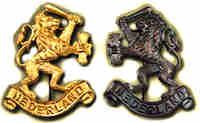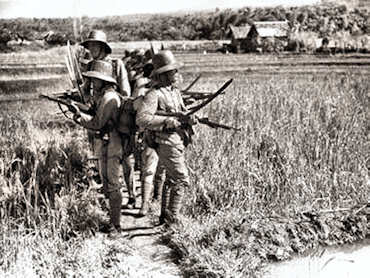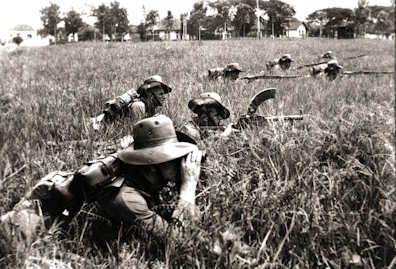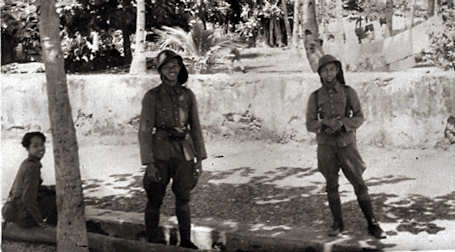|
SPARROW FORCE UNITS |
|
 KNIL (NEI) collar badges  KNIL section on exercise  KNIL section on exercise  Native KNIL soldiers  Dutch officers with natives |
NETHERLANDS EAST INDIES FORCES...
The
Koninklijk Nederlands Indisch Leger or KNIL is more often referred
to in English as the Netherlands East Indies or NEI. This was the
colonial Dutch armed establishment in the Dutch East Indies, modern
day
Indonesia. After active campaigns subjugating the island chain of
the archipelago, when resistance was finally crushed, the role of
NEI forces was primarily administrative and policing work. Dutch
presence commenced with the Dutch East India Company (VOC) in 1602.
Its influence was huge, far outclassing its British, French, Spanish
and Portuguese rivals in the region. Dissolved in 1800, the area
became the Netherlands East Indies.
The KNIL was formed in 1830 with European
officers and native levies and territorial expansion continued.
Establishment of the KNIL coincided with expansion of colonial rule
to include virtually all the islands of today's Indonesia. Conscription was instituted in 1917 and
with the Dutch having been in the East Indies for hundreds of years,
most of mixed-blood inhabitants worked for the public service,
police or military.
The main centre of government was Batavia, modern day Jakarta, on
the island of Java.
From 1940 when Germany overran Europe, the
Netherlands East Indies could no longer rely on supply from the
homeland. The Dutch looked towards Australia for supply of
munitions and military hardware. The Dutch looked towards Australia
and potential allies to bolster its military forces but needed to
maintain control over its territories. Long term friction with
Portugal, which held the east end of the island and an enclave in
the north, did not help the situation either.
By the time that Japan entered the war, Timor had about 600 officers
and soldiers on duty. There was a sizeable Dutch naval presence although most of the ships were old. These included the Surabaya, an old coastal training cruiser that was a renamed Royal Netherlands Navy armoured warship, the De Zeven Provincien between 1910 and 1942. At 6,530 tons, it was armed with two 11-inch, four 6-inch, ten 3-inch and four 37mm guns. This conveyed the 2nd Ind. Coy. and Dutch forces to Dili in December 1941. There was no Dutch air force presence on Timor.
When the Japanese Imperial forces landed on 20th February 1941, KNIL
units defended the left flank from the deepwater port Tenau to the
2/40th B
Company lines at Klapalima where the coastal guns were installed.
By
landing behind the prepared defences, months of preparation were for
naught and the positions were abandonned.
|
|
Copyright © 2012-2013 Please report any site problems/questions such as broken links here. |
|